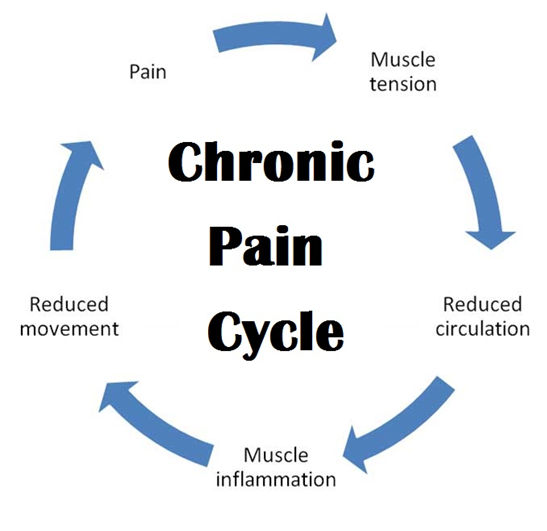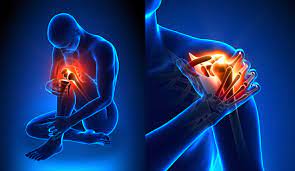WHAT IS CHRONIC PAIN?
Body’s normal reaction to any injury or illness, a warning that something is wrong is pain. If the pain lasts for 3 to 6 months or more it is referred to as chronic pain or chronic pain syndrome (CPS).
Chronic pain usually is near-constant, there may be flares of intense pain which is caused due to increase in stress or activity. People might also experience symptoms beyond pain like sleeping disorder, depression and anxiety interfering in their daily activities.

CAUSE OF CHRONIC PAIN
The roots of chronic pain are both physical and mental. Chronic pain would continue long after the recovery from the injury. Chronic pain can be caused by injury, long-lasting illness or sometimes without any underlying reason.
Pain that is not connected to any illness or injury is known as psychogenic pain or psychosomatic pain that is caused by psychological factors like stress, depression or anxiety. Psychological factors trigger the secretion of endorphins; the low level of the endorphins in blood might trigger the pain.
SYMPTOMS OF CHRONIC PAIN
The main symptom of chronic pain is persistent pain that lasts for 3-6 months or more. Chronic pain feels like aching, burning, shooting, squeezing, stiffness, stinging and throbbing sensation. This pain is triggered by injury, illness or no underlying cause. Chronic pain can lead to other symptoms like:
- Loss of weight
- Mood swings
- Anxiety, depression or irritation
- Insomnia or loss of sleep
- Fatigue or feeling tired
- Loss of sexual interest
- Might also lead to suicidal thoughts
- Dependent on painkillers
- Limited ability to move around
- Changes in appetite
Pain can only be identified and described by the person suffering from it. Healthcare providers would recommend blood tests, electromyography to check muscle activity, imaging tests like X-rays and MRI, nerve conduction to test nerves reaction, reflex and balance tests, spinal fluid tests and urine tests to study any underlying cause for the pain. These tests would help start the right treatment.

TREATMENT OF CHRONIC PAIN
It is important to identify the reason for the chronic pain to start the treatment that relieves the pain. If no reason could be identified, pain management is the only alternative.
The treatment regime would include medication, therapies and lifestyle changes. Emotional stress makes the pain even worse. It can be difficult to work with constant pain, and pain management makes it less difficult for you to work and carry on daily activities.
Medication – Medicines prescribed are a combination of painkillers, antidepressants, and anticonvulsants. Sedatives are used for people who are experiencing insomnia, anxiety or depression due to chronic pain.
You are at greater risk of athlete’s foot if you:
Over-the-counter medicine (OTC) – These medicines can be purchased from chemists without any prescription. Most common medicines are acetaminophen (Tylenol) and non-steroidal anti-inflammatory drugs (NSAIDs) like aspirin, ibuprofen and naproxen. These provide relief from mild pain, reduce inflammation and swelling.
Anticonvulsants – This prevents seizure and reduces pain that is caused by damaged nerves. Common prescribed anticonvulsants are gabapentin and pregabalin.
Antidepressants – These are used to treat long-term pain by affecting the neurotransmitters in your spine that send pain signals to the brain. They also help in addressing other symptoms related to pain like depression and anxiety.
Corticosteroids – They help in reducing the inflammation and control certain types of pain by altering the immune system, reducing inflammation that causes pain as well as decreases movement. These act like naturally occurring steroids in the body.
Muscle relaxers – These help in reducing stiffness, muscle spasm (involuntary muscle contractions) that are related to the spine, as well as limit your mobility. These provide improved movement; increase range of motion and decrease the pain.
Opioids – These are narcotics based painkillers, which bind to receptors in the brain to reduce the intensity of pain signals reaching the brain.
Topical ointments or gels that are applied on the affected area helps in reducing pain and provide a soothing effect (heat or cold).
Nonsteroidal anti- inflammatory drugs (NSAIDs) or acetaminophen – These block the production of chemicals that cause inflammation. They help in reducing pain that is caused by slow tissue damage; like arthritis pain, back pain, menstrual cramps and headaches
Therapies – Certain therapies help in reducing the pain as well as the need for medication.
Cognitive behavioral therapy (CBT) – It helps in pain management by changing the way you think about pain. This therapy is helpful when the pain is caused by emotional distress rather than physical distress. CBT includes practicing yoga, muscle relaxation and guided imagery.

Physical Therapy – This is helpful in case of long-term pain or pain caused by injury or illness. With physical therapy you strengthen your muscles as well as move & carry on daily activities with ease. The therapy consists of low-impact aerobic exercise, strengthening exercise, pain relief exercise and stretching exercise. Application of heat or ice pack also helps in alleviating pain by reducing inflammation and improves movement.
Trans-cutaneous Electrical Nerve Stimulation (TENS) – These send small amounts of electric signals to the affected area of the body. The electric signal interrupts with the pain signals thereby triggering the release of endorphins (body’s natural painkiller).
Biofeedback – This therapy helps in relaxation of the muscles or reducing stress that cause the pain. Biofeedback is helpful in lowering pain in conditions like abdominal pain, back pain, headaches, temporomandibular joint disorders (TMJ) and fibromyalgia. It also helps in symptoms related to pain like anxiety, urinary incontinence etc. Electrodes are attached to your skin during a biofeedback session. The electrodes or sensors would send signals to the attached monitor. This would display a sound, flash of light, or image which represents your heart and breathing rate, blood pressure, skin temperature, sweating, or muscle activity These help in relaxing the muscles and reduce anxiety.
Lifestyle changes – Some chronic pain last for a very long time and you might have to learn to live with the pain. Pain management helps in carrying out the daily activities without difficulty.
Exercise – Regular exercise helps in reducing the pain by releasing the naturally occurring pain killers called endorphins in the body. Physiotherapist would recommend some exercise which would help in increasing the range of motion, decreasing inflammation, and improve your mental and emotional well being. This also reduces the dependency on medicine and the body heals faster and the pain is alleviated more effectively.
Acupuncture and acupressure – These are traditional Chinese therapies that relieves the pain by manipulating acupoints of your body. Endorphins are released that block the pain message to be delivered to the brain.
Relaxation – Meditation, yoga and massage also help in reducing stress and decreasing muscle tension. They also help in strengthening the muscles and improve flexibility of the body.
OUTLOOK
It is difficult to live with chronic pain. Chronic pain doesn’t go away soon, but you can manage it with a combination of medicines, therapies and lifestyle changes. Advancement in neuroscience as well as better understanding of the human body leads to more effective treatments and treating chronic pain with ease.
There is no cure for chronic pain but the underlying cause can be treated with medications, therapies and lifestyle changes.
If you or anyone you know is suffering from chronic pain, our expert providers at Specialty Care Clinics will take care of your health and help you recover.
Call us on 469-545-9983 to book an appointment with Dr. Rao Kamran Ali.
